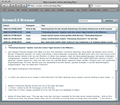Screen2.0
links // 2009.02.11 08:18:58 [hh]
"Thinking Machine 4": einem Schachprogramm beim Denken zuschauen
Das Kunstprojekt "Thinking Machine 4" von Martin Wattenberg und Marek Walczak versucht, die Suche eines Schachprogrammes zu visualisieren, indem Einflußbereiche und mögliche Züge farbig eingezeichnet werden. Das Ergebnis des mit "Processing" verfaßten Java-Applets ist eine interessante Landkarte für eine Schach-Position.
Wattenberg und Walczak auf ihrer englischsprachigen Web-Site: "Thinking Machine 4 explores the invisible, elusive nature of thought. Play chess against a transparent intelligence, its evolving thought process visible on the board before you.
The artwork is an artificial intelligence program, ready to play chess with the viewer. If the viewer confronts the program, the computer's thought process is sketched on screen as it plays. A map is created from the traces of literally thousands of possible futures as the program tries to decide its best move. Those traces become a key to the invisible lines of force in the game as well as a window into the spirit of a thinking machine.
Chess is a game of position. The position of your pieces in relation to your opponent’s pieces is crucial. You constantly have to evaluate these positions and set up goals and long term tactics.
You have to be aware of the value of the pieces on the board, the control of key squares, the safety of the king and how the pawns are structured. When you make a move you always have to consider all the possible moves that your opponent might make.
An easy way to evaluate the game in a given moment is by calculating the total value of all the pieces left on the board. These values vary with position, but in the most basic calculations a pawn is given one point, bishops and knights three points each, rooks five points and queens nine points. The points change depending of the position of a particular piece and how the pieces are coordinated. This means that an advanced pawn is worth more than one that’s still in the starting square and that a cornered bishop is worth less than out in the open. The importance of position is something chess has in common with both backgammon and most games for poker. Another similarity is the importance of thinking ahead.
The side controlling most space on the board usually has an advantage in chess. The more space, the more options to exploit. What you want to do is to have control of the center of the board. An important factor here is the pawn structure. The pawns are the least valuable and least mobile pieces in the game and the pawn structure is relatively static. How the pawns are structured largely determines the strength of your position – weaknesses in the pawn structure is usually very hard or even impossible to repair."
Weitere Informationen: www.turbulence.org/ spotlight/ thinking/ chess.html
Werbung












